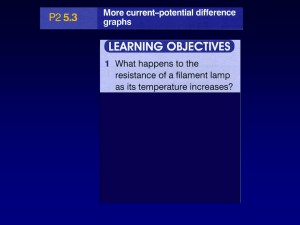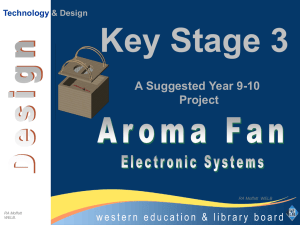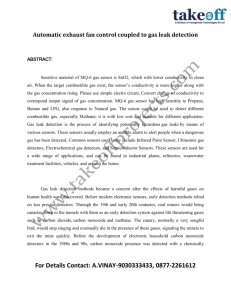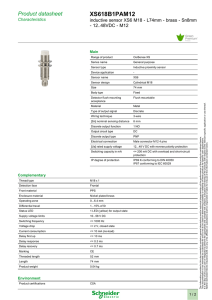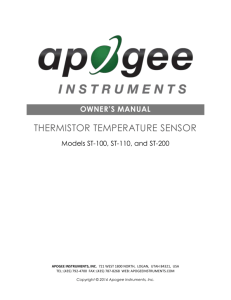TS-100 - Apogee Instruments, Inc.
advertisement
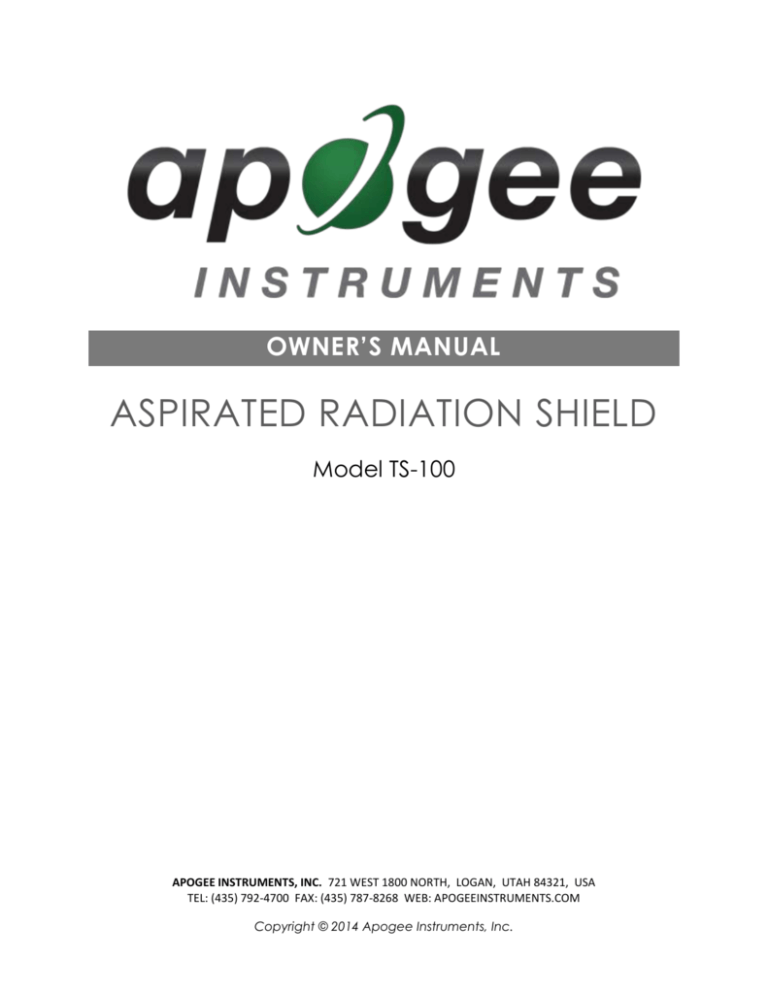
OWNER’S MANUAL ASPIRATED RADIATION SHIELD Model TS-100 APOGEE INSTRUMENTS, INC. 721 WEST 1800 NORTH, LOGAN, UTAH 84321, USA TEL: (435) 792-4700 FAX: (435) 787-8268 WEB: APOGEEINSTRUMENTS.COM Copyright © 2014 Apogee Instruments, Inc. 2 TABLE OF CONTENTS DECLARATION OF CONFORMITY ................................................................................................................... 4 INTRODUCTION ............................................................................................................................................. 5 SENSOR MODELS........................................................................................................................................... 6 SPECIFICATIONS ............................................................................................................................................ 7 DEPLOYMENT AND INSTALLATION ............................................................................................................. 10 OPERATION AND MEASUREMENT .............................................................................................................. 12 MAINTENANCE AND RECALIBRATION......................................................................................................... 16 TROUBLESHOOTING AND CUSTOMER SUPPORT ........................................................................................ 17 RETURN AND WARRANTY POLICY............................................................................................................... 19 3 4 DECLARATION OF CONFORMITY CE and ROHS Certificate of Compliance We Apogee Instruments, Inc. 721 W 1800 N Logan, Utah 84321 USA Declare under our sole responsibility that the products: Models: TS-100, ST-110, ST-300 Type: Aspirated Radiation Shield and Temperature Sensors are in conformity with the following standards and relevant EC directives: Emissions: EN 61326-1:2013 Immunity: EN 61326-1:2013 EU directive 2004/108/EC, EMC EU directive 2006/95/EC, Low Voltage Directive – Annex 1: Safety Objectives EU directive 2002/95/EC, RoHS (Restriction of Hazardous Substances) EU directive 2011/65/EU, RoHS2 Please be advised that based on the information available to us from our raw material suppliers, the products manufactured by us do not contain, as intentional additives, any of the restricted materials including cadmium, hexavalent chromium, lead, mercury, polybrominated biphenyls (PBB), polybrominated diphenyls (PBDE). Further note that Apogee Instruments does not specifically run any analysis on our raw materials or end products for the presence of these substances, but rely on the information provided to us by our material suppliers. Bruce Bugbee President Apogee Instruments, Inc. August 2013 5 INTRODUCTION Properties of materials and nearly all biological, chemical, and physical processes are temperature dependent. Temperature is also a fundamental weather variable. As a result, temperature is perhaps the most widely measured environmental variable. Aspirated radiation shields are designed to shield temperature and humidity sensors from incident solar radiation while maintaining equilibrium with ambient air through fan aspiration. Typical applications of aspirated radiation shields include air temperature and humidity measurements in weather networks, often for weather forecasting. Air temperature and humidity are critical input variables for calculation of evapotranspiration and irrigation scheduling. Aspirated shields are also important in the precise measurement of air temperature and humidity gradients above the land surface. Apogee Instruments model TS-100 aspirated radiation shields are made from high-quality injection-molded plastic with low thermal conductivity, maximum weather resistance, and a gloss white finish for high reflectivity. The small size makes it easy to work with and reduces the surface area exposed to incoming radiation. The shield is designed as a lightweight, low power, and low cost alternative to other aspirated and un-aspirated shields for air temperature and humidity measurement. The efficient, low-power fan draws ambient air into the shield using a rocket nozzle contour to maximize airflow around the internal sensors. The curved inlet helps draw air into the shield during high cross winds. These unique properties make the TS-100 ideal for use in remote locations with limited power supply. All Apogee TS-100 shields come with a precision air temperature sensor (model ST-110, thermistor). ST-110 air temperature sensors are weatherproof, have excellent long-term stability, and are designed for continuous air temperature measurement when housed in the TS-100. ST110 thermistors offer improved accuracy over thermocouples. The advantages of thermistors over platinum resistance thermometers (PRTs) are high signal-to-noise ratio, requirement of only a single-ended channel for measurement, and lower cost. Accelerated aging tests indicate that the epoxy-encased ST-110 thermistor has a long-term stability equal to more expensive reference PRTs. However, TS-100 shields are designed to optionally accommodate PRTs with a custom adapter. Measurement errors due to thermal conduction of heat to the sensor are minimized by reflective white heat shrink tubing, and shading of lead wire on the north side of the shield (in the northern hemisphere; south side of shield in southern hemisphere). Thermal conductivity to the precision thermistor is further minimized by using constantan wire, which has twenty-fold lower thermal conductivity than copper wire. 6 SENSOR MODELS TS-100 aspirated radiation shields accommodate multiple air temperature and humidity sensors using sensor port adapters. The following standard options are available: Apogee Instruments model ST-110 shield) (precision thermistor for air temperature, included with Apogee Instruments model ST-300 (PRT option for air temperature) Campbell Scientific model CS215 (probe for air temperature and humidity) Vaisala models HMP110 and HMP60 (probes for air temperature and humidity) Rotronic model HC2-S3 (probe for air temperature and humidity) All sensor port adapters are designed to hold a ST-110 or ST-300 (user selected) air temperature sensor and a temperature/humidity probe (if desired). Aspirated shield model and serial number are printed on white heatshrink tubing located near the pigtail leads on the fan cable. Temperature sensor model number and serial number are located near the pigtail leads on the sensor cable. 7 SPECIFICATIONS TS-100 Radiation-induced Temperature Increase (RITI): There is no reference standard for the elimination of radiation effects on air temperature measurement, but well-designed aspirated shields minimize this effect. In the absence of a standard, RITI was analyzed in long-term tests over snow and grass surfaces by comparing temperature measurements from nine replicate TS-100 shields to measurements from two replicate aspirated shields from Met One (model 076B) and two replicate aspirated shields from R. M. Young (model 43502). Comparisons among shields were made with ST-110 thermistors in all shields. In spite of careful placement of shields away from each other and the tower (see photo below), and filtering for wind direction, these tests indicate that there is more variability among replicate shields (± 0.1 C) of the same model than between models of shields (± 0.03 C), thus there is no statistical difference among the three models of shields. Field tests indicate that low wind speed has a greater effect on RITI than high radiation load. For conditions of solar radiation greater than 800 W m-2 and wind speeds less than 2 m s-1, the mean of the Apogee model TS-100 shields has been within 0.03 C of the means of the other two models of shields. At higher wind speeds, the TS-100 and R. M. Young shields read slightly cooler (-0.05 C) than the mean of the Met One shields, but the difference is not statistically significant. Difference Among Individual Replicate Shields: < 0.1 C Aspiration Rate: 6 m s-1 at full speed; 3 m s-1 at half speed Fan Input Voltage Requirement: 12 V DC Fan Current Drain: 80 mA at full speed; 25 mA at half speed 8 Fan dust and water protection: IP55 The fan is extremely well sealed against water and dust, with an ingress protection rating of 55, called IP55. The higher the number the better the protection. Fans typically range from IP11 to IP55. The first digit in the IP rating indicates protection against particle entry. A 5 indicates minimal dust entry with no interference with fan operation. The second digit indicates water protection. A 5 indicates that water sprayed on the fan from any direction shall have no harmful effects. Typical fans have particle and water protection ratings of 2 to 3, indicating moderate particle and water protection, but no dust protection. Dimensions: 22 cm height, 27 cm diameter Mass: 840 g Cables: 5 m of shielded, twisted-pair wire for fan and air temperature sensors Additional cable available in multiples of 5 m Santoprene rubber jacket (high water resistance, high UV stability, flexibility in cold conditions) Pigtail lead wires ST-110 (Precision Thermistor) Measurement Range: -50 to 70 C Measurement Uncertainty: 0.1 C (from 0 to 70 C) 0.15 C (from -35 to 0 C) Measurement Repeatability: < 0.01 C Non-stability (Long-term Drift): < 0.02 C per year (when used in non-condensing environments where the annual average temperature is less than 30 C; continuously high temperatures or continuously humid environments increase drift rate) Equilibration Time: 5 s Self-Heating: < 0.01 C (typical, assuming pulsed excitation of 2.5 V DC) 0.08 C at 5 C (maximum, assuming continuous input excitation of 2.5 V DC) Operating Environment: -50 to 70 C 0 to 100 % relative humidity Input Voltage Requirement: 2.5 V DC excitation (recommended, see OPERATION AND MEASUREMENT section) Output Voltage Range: 0 to 2.5 V DC (assuming input excitation of 2.5 V DC) Current Drain: 0.1 mA DC at 70 C (maximum, assuming continuous input excitation of 2.5 V DC) Dimensions: 7 cm length, 0.2 cm diameter 9 Mass: 60 g ST-300 (Platinum Resistance Thermometer) Measurement Range: -50 to 70 C Measurement Uncertainty: 0.2 C (from -40 to 60 C) Measurement Repeatability: < 0.01 C Non-stability (Long-term Drift): < 0.05 C per year Equilibration Time: 15 s Operating Environment: -50 to 70 C 0 to 100 % relative humidity Input Voltage Requirement: 2.1 V DC excitation (recommended, see OPERATION AND MEASUREMENT section) Output Voltage Range: 16 to 27 mV DC (assuming continuous input excitation of 2.1 V DC) Current Drain: 0.21 mA DC (maximum, assuming continuous input excitation of 2.1 V DC) Dimensions: 5.1 cm length, 0.32 cm diameter Mass: 95 g 10 DEPLOYMENT AND INSTALLATION TS-100 aspirated radiation shields come partially pre-assembled and have few parts, facilitating easy transport, deployment, and maintenance. Avoid placing the shield near buildings, paved surfaces, or any other locations which may create a micro-environment significantly different than ambient environment. The World Meteorological Organization (WMO) recommends a mounting height of 1.25 to 2 meters above ground. Air temperature typically decreases with increasing height above the ground surface. The shield is designed to hang from a standard IPS horizontal pipe ranging from 1¼ inch (32 mm) to 2 inch (51 mm) in diameter. Attach the hat to the pipe with the U-bolt, nuts, and rubber washers provided (see diagram at left). Then, insert the shorter threaded end of the nylon standoffs into the shield body. Once in place, align the other end of the standoffs to the four corresponding holes in the hat and secure with nylon nuts. Ensure that the sensor port (the hole in the side of the shield where the air temperature and/or humidity probe mounts) faces the nearest global pole (north for northern hemisphere, south for southern hemisphere) to maximize shading of the lead wires. The precision thermistor comes fixed inside a sensor port adapter (shown on next page). If not already installed, insert the adapter into the sensor port (shown on next page) and rotate the adapter until it matches the shield’s outer contour and will not come out when pulled. Look 11 through the opening at the bottom of the shield to verify that the thermistor tip is located concentrically in the middle of the airstream. If it is not, remove the adapter and adjust the thermistor tip accordingly. If desired, a humidity probe may be used with its accompanying sensor port adapter. If not preinstalled, slowly insert the humidity probe into the adapter until the tip is far enough to be in the air stream (about as far as the included thermistor). If the o-rings bind or come lose, back out the probe, fix the o-ring positioning, and retry. Rotating the humidity probe while inserting will help the o-rings stay in place. Additionally, the light use of a lubricant, such as petroleum jelly, will greatly help humidity probe installation, and reduce risk of misplaced o-rings. While installing the humidity probe, be sure not to put any unnecessary force on the neighboring pre-installed thermistor cable; it has very thin internal wires which could easily break if handled incorrectly. The underside of the hat has eight flat surfaces where one or more included cable tie mounts may affix. Using the cable tie mounts is optional, but provides an anchor to zip-tie cables to, providing strain relief, extra shading of cable, and a drip loop in the cable. 12 OPERATION AND MEASUREMENT Connect the sensor to a measurement device (meter, datalogger, controller) capable of inputting 2.5 V DC, and measuring and displaying or recording a millivolt (mV) signal (an input measurement range of 0-2500 mV is required to cover the entire temperature range of the ST110 air temperature sensor). In order to maximize measurement resolution and signal-to-noise ratio, the input range of the measurement device should closely match the output range of the sensor. Connect the fan to a 12 V DC power supply capable of supplying at least 80 mA. If the datalogger has the capability for pulse width modulation (PWM) it can be used to reduce fan speed at night or under conditions of low solar radiation and/or high wind speed. The datalogger or controller must have a pulse width modulation (PWM) output of approximately 20 kHz and a duty cycle of 50 to 100 %. The tachometer output is measured by a pulse counter. The tachometer also requires an input voltage, where maximum voltage output to the pulse counter is the input voltage to the counter. The tachometer output allows monitoring of the fan to ensure it is functioning properly. Plug each wire into the appropriate data logger terminal following the illustrations below: Thermistor: Measurement devices (e.g., datalogger, controller) do not measure resistance directly, but determine resistance from a half-bridge measurement, where an excitation voltage is input across the thermistor and an output voltage is measured across the bridge resistor. 13 An excitation voltage of 2.5 V DC is recommended to minimize self-heating and current drain, while still maintaining adequate measurement sensitivity (mV output from thermistor per C). However, other excitation voltages can be used. Decreasing the excitation voltage will decrease self-heating and current drain, but will also decrease thermistor measurement sensitivity. Increasing the excitation voltage will increase thermistor measurement sensitivity, but will also increase self-heating and current drain. Conversion of Thermistor Resistance to Temperature: The thermistor is a resistive element, where resistance changes with temperature. Thermistor resistance (RT, in ) is measured with a half-bridge measurement, requiring a known excitation voltage input (VEX) and a measurement of output voltage (VOUT): V R T 24900 EX 1 V OUT (1) where 24900 is the resistance of the bridge resistor in . From resistance, temperature (T, in Kelvin) is calculated with the Steinhart-Hart equation and thermistor specific coefficients: TK 1 A B ln( R T ) C(ln( R T )) 3 (2) where A = 1.129241 x 10-3, B = 2.341077 x 10-4, and C = 8.775468 x 10-8 (Steinhart-Hart coefficients). If desired, measured temperature in Kelvin can be converted to Celsius (TC): TC TK 273 .15 . (3) 14 PRT: Measurement of PRT resistance is very similar to measurement of thermistor resistance, where a half-bridge measurement is used. An excitation voltage is input across the bridge resistor and an output voltage is measured across the PRT. An excitation voltage of 2.1 V DC is recommended to minimize current drain, while still maintaining an adequate voltage signal. However, other excitation voltages can be used. Decreasing the excitation voltage will decrease current drain, but will also decrease output voltage. Increasing the excitation voltage will increase output voltage, but will also increase current drain. Conversion of PRT Resistance to Temperature: 15 The PRT is a resistive element, where resistance changes with temperature. PRT resistance (R PRT, in ) is measured with a half-bridge measurement, requiring a known excitation voltage input (V EX) and a measurement of output voltage (VOUT): R PRT 1000 VOUT VEX VOUT (1) where 10000 is the resistance of the bridge resistor in . From resistance, temperature (TC, in Celsius) is calculated with a second order polynomial and PRT-specific coefficients: TC C2 R PRT C1 R PRT C0 2 (2) where C2, C1, and C0 are coefficients determined from factory calibration and provided on a calibration sheet included with the PRT. Fan Operation: Under some environmental conditions (e.g., high wind speed, low solar radiation), accurate measurements can be made without running the fan at full speed. Fan speed and power consumption can be decreased using a pulse width modulation (PWM) signal. The PWM signal should have a frequency of approximately 20 kHz and a duty cycle of 50 to 100 %, where a duty cycle of 100 % is full power and 50 % is low power. Running the fan in a low power mode reduces the current drain from 80 mA to approximately 25 mA. The only way to completely stop the fan is to turn the power off. The fan also has a tachometer to monitor blade revolutions per minute (RPM). The tachometer outputs a pulse voltage signal. The pulse multiplied by 30 yields fan RPMs. The RPM should be near 4500 in full power mode and 2500 in low power mode. In addition to the tachometer output wire, there is a pull-up wire (power input). This allows a user-defined maximum output voltage from the tachometer, and facilitates interfacing with multiple measurement devices. 16 MAINTENANCE AND RECALIBRATION At full duty, the fan is designed to last 50,000 hours (5.7 years). Ultimately, this depends on operating conditions, and actual results may vary. If the fan runs less than approximately 4500 RPM at full power, then there may be a blockage or the fan may need to be replaced. The fan is secured by four nylon screws and can be easily removed. When a replacement fan is installed, verify that it is oriented the correct way, with air being pulled upwards through the shield towards the hat. Ensure that the replacement fan is wired correctly as outlined in the OPERATION AND MEASUREMENT section. Inspect the shield regularly and clean as needed to maintain optimum performance. If the shield or hat is dirty, wipe the surface with a moist rag to remove buildup and return the surface to its original condition. Check all mounting nuts and tighten if they are loose. For optimal accuracy, check the yellow-bead thermistor every three months for dust/dirt buildup. If needed, twist and pull out the sensor port adapter, then wipe the thermistor tip clean. Be sure to return the thermistor to its proper position as outlined in the DEPLOYMENT AND INSTALLATION section. Apogee ST-110 and ST-300 temperature sensors are factory calibrated and come with sensorspecific calibration coefficients. Sensors are calibrated for absolute temperature against the mean of two reference PRTs in a constant temperature bath, over a range of approximately -35 to 60 C. The reference PRT calibrations are directly traceable to the NIST. 17 TROUBLESHOOTING AND CUSTOMER SUPPORT Independent Verification of Functionality: Apogee ST-110 temperature sensors yield a resistance proportional to temperature. A quick and easy check of sensor functionality can be accomplished with an ohmmeter. Connect the lead wires of the ohmmeter to the black and red wires from the sensor. The resistance should read 10 k (10,000 ohms) at 25 C. If the sensor temperature is less than 25 C, the resistance will be higher. If the sensor temperature is greater than 25 C, the resistance will be lower. Connect the lead wires of the ohmmeter to the black and blue wires from the sensor. The resistance should read 24.9 k, and should not vary. Connect the lead wires of the ohmmeter to the red and blue wires from the sensor. The resistance should be the sum of the resistances measured across the black and red wires, and black and blue wires (e.g., 10 k plus 24.9 k at 25 C). Apogee ST-300 temperature sensors yield a resistance proportional to temperature. A quick and easy check of sensor functionality can be accomplished with an ohmmeter. Connect the lead wires of the ohmmeter to the red/black (red and black are connected internally, without a resistor between them; continuity between red and black indicates both wires are functional) and white wires from the sensor. The resistance should read 100 (0.1 k) at 0 C. If the sensor temperature is less than 0 C, the resistance will be lower. If the sensor temperature is greater than 0 C, the resistance will be higher. Connect the lead wires of the ohmmeter to the red/black and orange wires from the sensor. The resistance should read 10 k, and should not vary. Connect the lead wires of the ohmmeter to the orange and white wires from the sensor. The resistance should be the sum of the resistances measured across the red/black and white wires, and red/black and orange wires (e.g., 100 plus 10 k at 0 C). A quick and easy check of fan functionality can be determined using a DC power supply. Power the fan with 12 V DC by connecting the positive voltage signal to the red wire from the fan and the negative (or common) to the black wire from the fan. When powered, the fan blades should spin. Make sure to keep fingers clear of blades before connecting fan to 12 V DC. Compatible Measurement Devices (Dataloggers/Controllers/Meters): Measurement of ST-110 thermistor resistance requires an input excitation voltage, where 2.5 V DC is recommended. Measurement of ST-300 PRT resistance also requires an input excitation voltage, where 2.1 V DC is recommended. A compatible measurement device should have the capability to supply the necessary voltage for the specific sensor. The sensitivity (mV output from thermistor per C) of the temperature measurement from the ST110 thermistor varies with the excitation voltage, and varies as a function of temperature. With an excitation voltage of 2.5 V DC, the sensitivity is lowest near the ends of the measurement range, -50 and 70 C. A compatible measurement device (e.g., datalogger or controller) should have resolution of at least 0.6 mV, in order to produce temperature resolution of less than 0.1 C across the entire temperature measurement range (less than 0.05 C from -35 to 45 C). 18 The sensitivity (mV output from PRT per C) of the temperature measurement from the ST-300 PRT is approximately constant across the entire measurement range. With an excitation voltage of 2.1 V DC, a compatible measurement device should have resolution of at least 0.008 mV, in order to produce temperature resolution of less than 0.1 C across the entire temperature measurement range. To operate the fan, a 12 V DC power supply capable of supplying at least 80 mA is required. All fans also include pulse width modulation (PWM; allows for reduction of fan speed under certain conditions) and a tachometer (allows for monitoring of fan speed). In order to use the PWM option, the fan must be connected to a datalogger or controller that has a PWM output of approximately 20 kHz, a duty cycle of 50 to 100 %, and a 0 to 5 V DC square waveform. To measure the output from the tachometer, a pulse counter is required. The maximum voltage input from the tachometer to the pulse counter is determined by the input voltage to the tachometer, which should be fixed at a given voltage in the range of 0 to 30 V DC. The measurement device should be capable of supplying a fixed voltage in this range. An example datalogger program for Campbell Scientific dataloggers can be found on the Apogee webpage at http://www.apogeeinstruments.com/content/Aspirated_Shield.CR1. Effect of Cable Length: When the temperature sensor is connected to a measurement device with high input impedance, sensor output signals are not changed by shortening the cable or splicing on additional cable in the field. Tests have shown that if the input impedance of the measurements device is 1 mega-ohm or higher then there is negligible effect on the sensors, even after adding up to 100 m of cable. TS-100 aspirated radiation shields use shielded, twisted pair cable, which minimizes electromagnetic interference. This is particularly important for long lead lengths in electromagnetically noisy environments. Modifying Cable Length: See Apogee webpage for details on how to extend sensor cable length (http://www.apogeeinstruments.com/how-to-make-a-weatherproof-cable-splice/). 19 RETURN AND WARRANTY POLICY RETURN POLICY Apogee Instruments will accept returns within 30 days of purchase as long as the product is in new condition (to be determined by Apogee). Returns are subject to a 10 % restocking fee. WARRANTY POLICY What is Covered All products manufactured by Apogee Instruments are warranted to be free from defects in materials and craftsmanship for a period of four (4) years from the date of shipment from our factory. To be considered for warranty coverage an item must be evaluated either at our factory or by an authorized distributor. Products not manufactured by Apogee (spectroradiometers, chlorophyll content meters) are covered for a period of one (1) year. What is Not Covered The customer is responsible for all costs associated with the removal, reinstallation, and shipping of suspected warranty items to our factory. The warranty does not cover equipment that has been damaged due to the following conditions: 1. Improper installation or abuse. 2. Operation of the instrument outside of its specified operating range. 3. Natural occurrences such as lightning, fire, etc. 4. Unauthorized modification. 5. Improper or unauthorized repair. Please note that nominal accuracy drift is normal over time. Routine recalibration of sensors/meters is considered part of proper maintenance and is not covered under warranty. Who is Covered This warranty covers the original purchaser of the product or other party who may own it during the warranty period. What We Will Do At no charge we will: 1. Either repair or replace (at our discretion) the item under warranty. 2. Ship the item back to the customer by the carrier of our choice. Different or expedited shipping methods will be at the customer’s expense. How To Return An Item 1. Please do not send any products back to Apogee Instruments until you have received a Return Merchandise Authorization (RMA) number from our technical support department by calling (435) 792-4700 or by submitting an online RMA form at www.apogeeinstruments.com/tech-support-recalibration-repairs/. We will use your RMA number for tracking of the service item. 20 2. Send all RMA sensors and meters back in the following condition: Clean the sensor’s exterior and cord. Do not modify the sensors or wires, including splicing, cutting wire leads, etc. If a connector has been attached to the cable end, please include the mating connector – otherwise the sensor connector will be removed in order to complete the repair/recalibration. 3. Please write the RMA number on the outside of the shipping container. 4. Return the item with freight pre-paid and fully insured to our factory address shown below. We are not responsible for any costs associated with the transportation of products across international borders. 5. Upon receipt, Apogee Instruments will determine the cause of failure. If the product is found to be defective in terms of operation to the published specifications due to a failure of product materials or craftsmanship, Apogee Instruments will repair or replace the items free of charge. If it is determined that your product is not covered under warranty, you will be informed and given an estimated repair/replacement cost. Apogee Instruments, Inc. 721 West 1800 North Logan, UT 84321, USA OTHER TERMS The available remedy of defects under this warranty is for the repair or replacement of the original product, and Apogee Instruments is not responsible for any direct, indirect, incidental, or consequential damages, including but not limited to loss of income, loss of revenue, loss of profit, loss of wages, loss of time, loss of sales, accruement of debts or expenses, injury to personal property, or injury to any person or any other type of damage or loss. This limited warranty and any disputes arising out of or in connection with this limited warranty ("Disputes") shall be governed by the laws of the State of Utah, USA, excluding conflicts of law principles and excluding the Convention for the International Sale of Goods. The courts located in the State of Utah, USA, shall have exclusive jurisdiction over any Disputes. This limited warranty gives you specific legal rights, and you may also have other rights, which vary from state to state and jurisdiction to jurisdiction, and which shall not be affected by this limited warranty. This warranty extends only to you and cannot by transferred or assigned. If any provision of this limited warranty is unlawful, void or unenforceable, that provision shall be deemed severable and shall not affect any remaining provisions. In case of any inconsistency between the English and other versions of this limited warranty, the English version shall prevail. This warranty cannot be changed, assumed, or amended by any other person or agreement. 21 APOGEE INSTRUMENTS, INC. 721 WEST 1800 NORTH, LOGAN, UTAH 84321, USA TEL: (435) 792-4700 FAX: (435) 787-8268 WEB: APOGEEINSTRUMENTS.COM Copyright © 2014 Apogee Instruments, Inc.
